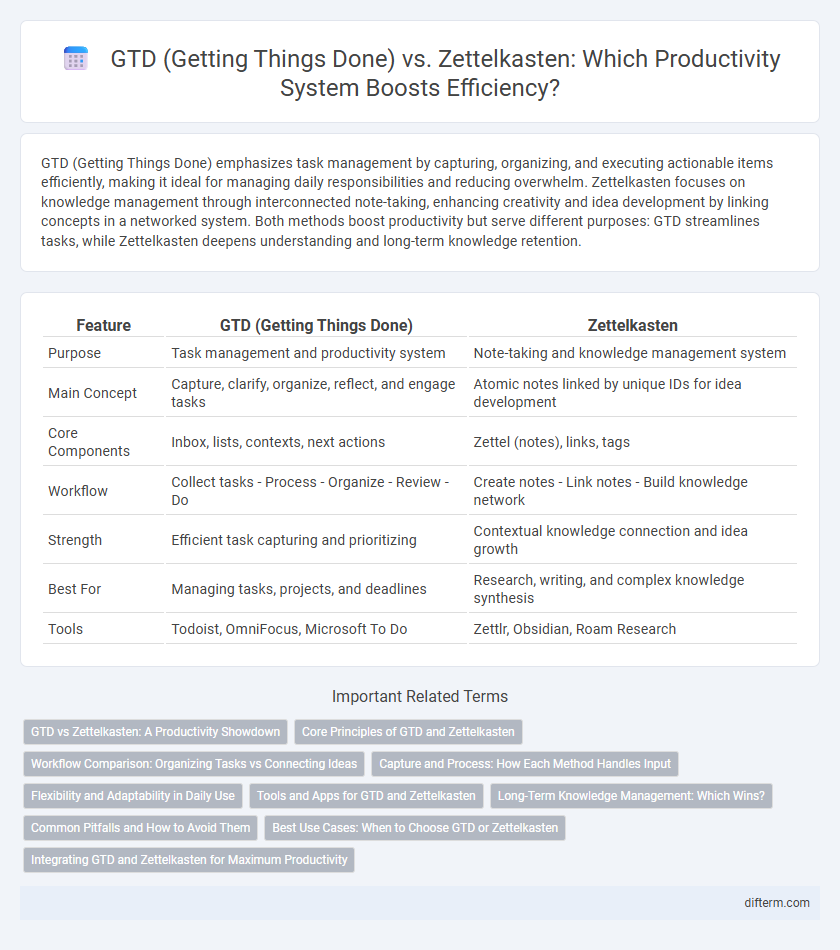GTD (Getting Things Done) emphasizes task management by capturing, organizing, and executing actionable items efficiently, making it ideal for managing daily responsibilities and reducing overwhelm. Zettelkasten focuses on knowledge management through interconnected note-taking, enhancing creativity and idea development by linking concepts in a networked system. Both methods boost productivity but serve different purposes: GTD streamlines tasks, while Zettelkasten deepens understanding and long-term knowledge retention.
Table of Comparison
| Feature | GTD (Getting Things Done) | Zettelkasten |
|---|---|---|
| Purpose | Task management and productivity system | Note-taking and knowledge management system |
| Main Concept | Capture, clarify, organize, reflect, and engage tasks | Atomic notes linked by unique IDs for idea development |
| Core Components | Inbox, lists, contexts, next actions | Zettel (notes), links, tags |
| Workflow | Collect tasks - Process - Organize - Review - Do | Create notes - Link notes - Build knowledge network |
| Strength | Efficient task capturing and prioritizing | Contextual knowledge connection and idea growth |
| Best For | Managing tasks, projects, and deadlines | Research, writing, and complex knowledge synthesis |
| Tools | Todoist, OmniFocus, Microsoft To Do | Zettlr, Obsidian, Roam Research |
GTD vs Zettelkasten: A Productivity Showdown
GTD (Getting Things Done) prioritizes task management through structured organization and clear next actions, enhancing productivity by reducing mental clutter and improving focus. Zettelkasten emphasizes knowledge management via interconnected notes, fostering creativity and deeper understanding by linking ideas contextually over time. Comparing GTD and Zettelkasten reveals a productivity showdown where GTD excels in actionable task execution, while Zettelkasten thrives in cultivating knowledge-based output and long-term intellectual growth.
Core Principles of GTD and Zettelkasten
GTD (Getting Things Done) centers on capturing tasks in a trusted system, clarifying next actions, organizing by context, reflecting regularly, and engaging with tasks systematically to boost productivity and reduce mental clutter. Zettelkasten focuses on creating atomic, interlinked notes that enhance knowledge retention, idea generation, and long-term project development by leveraging connections between concepts. Both systems prioritize externalizing cognitive processes but differ in scope: GTD manages actionable tasks, while Zettelkasten structures knowledge and insights for creative work.
Workflow Comparison: Organizing Tasks vs Connecting Ideas
GTD (Getting Things Done) excels in workflow by systematically organizing tasks into actionable steps, prioritizing productivity through clear contexts and next actions. In contrast, Zettelkasten emphasizes connecting ideas via a networked note-taking system that fosters creativity and deep understanding by linking concepts across topics. While GTD structures task execution for efficiency, Zettelkasten enhances knowledge development through meaningful interconnections between thoughts.
Capture and Process: How Each Method Handles Input
GTD (Getting Things Done) emphasizes a streamlined capture system where all inputs are collected in a trusted inbox for immediate clarification and organization into actionable tasks, projects, or reference materials. Zettelkasten focuses on capturing atomic, context-rich notes linked through a network of connections, facilitating deeper processing and knowledge development rather than task management. While GTD excels in organizing and processing heterogeneous inputs into a clear workflow, Zettelkasten prioritizes the incremental synthesis of ideas through a continuous, interconnected note-taking process.
Flexibility and Adaptability in Daily Use
GTD (Getting Things Done) offers structured task management with clear workflows, enhancing flexibility by breaking down projects into actionable steps adaptable to shifting priorities. Zettelkasten emphasizes dynamic knowledge organization through interconnected notes, enabling adaptability by fostering idea evolution and deeper insight generation over time. Integrating GTD's task clarity with Zettelkasten's flexible knowledge network supports seamless daily productivity adjustments.
Tools and Apps for GTD and Zettelkasten
GTD tools like Todoist, OmniFocus, and Microsoft To Do streamline task management through clear project hierarchies and context-based reminders, optimizing focus and task completion. Zettelkasten apps including Obsidian, Roam Research, and Zettlr emphasize linking notes and knowledge snippets, fostering deep connections and idea development. Choosing between GTD and Zettelkasten tools depends on whether productivity goals prioritize actionable task tracking or expansive knowledge organization.
Long-Term Knowledge Management: Which Wins?
GTD (Getting Things Done) excels in short-term task organization and immediate productivity, while Zettelkasten shines in long-term knowledge management by creating a connected, evolving web of ideas. Zettelkasten's atomic notes and unique ID system foster deep understanding and knowledge synthesis, aiding research and creative projects over time. For sustained intellectual growth and complex information retrieval, Zettelkasten offers a superior framework compared to GTD's task-driven approach.
Common Pitfalls and How to Avoid Them
GTD frequently suffers from overwhelm due to excessive task lists and unclear next actions, which can be mitigated by strict weekly reviews and prioritizing context-specific tasks. Zettelkasten's main pitfall is inconsistent linking and note fragmentation, avoidable by maintaining a daily note habit and ensuring atomic, interconnected entries. Balancing task management in GTD with knowledge synthesis in Zettelkasten enhances productivity without falling into inefficiency traps.
Best Use Cases: When to Choose GTD or Zettelkasten
GTD (Getting Things Done) excels in managing tasks and projects with a clear workflow ideal for prioritizing, scheduling, and tracking actionable commitments in professional and personal settings. Zettelkasten is best suited for knowledge management, note-taking, and idea development, particularly useful for researchers, writers, and learners who need to connect and organize complex information. Choosing GTD is optimal when the goal is task completion and reducing mental clutter, while Zettelkasten is preferred for cultivating deep understanding and generating creative insights over time.
Integrating GTD and Zettelkasten for Maximum Productivity
Integrating GTD (Getting Things Done) with Zettelkasten creates a powerful productivity system by combining actionable task management with a dynamic knowledge repository. GTD's structured workflow captures and processes tasks efficiently, while Zettelkasten connects ideas and enhances memory through linked notes. Leveraging both methods maximizes clarity, creativity, and execution, enabling seamless project tracking alongside deep knowledge retention.
GTD (Getting Things Done) vs Zettelkasten Infographic

 difterm.com
difterm.com